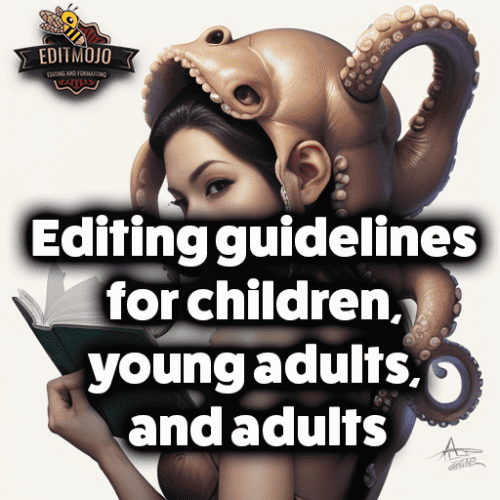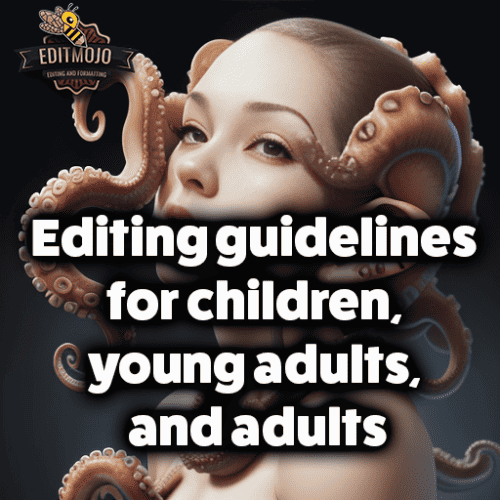Editing guidelines for children, young adults, and adults
Editing guidelines for children, young adults, and adults. Editing is a skill that can be honed at any age. It is much like sculpting. As the famous quote goes, “The sculpture is already complete within the marble block before I start my work. It is already there, I just have to chisel away the superfluous material.”[^1^] The same philosophy applies to the art of editing. It’s all about chiseling away the unnecessary words and refining the thoughts to bring out the story that’s already there.
What makes editing even more interesting is the importance of adapting the process to match the cognitive and psychological development of each age group. In this article, we explore the art of editing from childhood to adulthood.
Key Takeaways Table
| Age Group | Key Takeaways |
|---|---|
| Children | • Importance of editing in developing basic literacy skills. • Focus on correcting basic grammar, punctuation, and spelling. • Use of games and interactive activities to make editing fun. |
| Young Adults | • Role of editing in academic and early career success. • Focus on enhancing clarity, coherence, and logical flow of ideas. • Importance of peer editing and utilizing advanced editing tools. |
| Adults | • Significance of editing in professional and personal writing. • Adherence to style guides and editing different types of professional documents. • Importance of continuous improvement of editing skills. |
Editing for Children
The Importance of Editing Skills for Children
Editing is a powerful tool that helps children enhance their reading and writing skills[^2^]. By practicing editing, they can build a solid foundation that prepares them for future academic and professional success. Think of it as laying the bricks for a house. A strong, well-laid foundation can support the structure that’s built on it.
Simple Editing Guidelines
At this stage, it’s important to focus on the basics: grammar, punctuation, and spelling. Here, children learn to identify sentence fragments, run-on sentences, or subject-verb disagreements. For example, they can start by correcting sentences like “She don’t have any apples” to “She doesn’t have any apples.”
As they progress, they can also start understanding consistency in verb tenses and improving the structure of their sentences for better readability.
Making Editing Fun for Children
The secret to getting children excited about editing is to make it fun! There are several games and interactive activities that can make editing a joy rather than a chore[^3^]. One could create a treasure hunt where the treasure is the correctly spelled words or a race to see who can spot the most grammatical errors.
Additionally, introducing them to child-friendly editing tools can make the process seem less daunting and more interactive.

Editing for Young Adults
The Role of Editing in Young Adults’ Lives
As young adults progress in their academic journey and step into early career paths, the role of editing becomes increasingly significant. It can mean the difference between an average essay and an A+ paper, or a rejection and an acceptance for a job application.
Advanced Editing Guidelines
The art of editing for young adults is not just about correcting errors but also about enhancing clarity and coherence, ensuring the logical flow of ideas, and checking the relevance and validity of arguments. It’s akin to assembling a puzzle – each piece must fit perfectly with the others to create a complete, coherent picture.
A crucial part of editing at this stage is also understanding the appropriate use of tone and style depending on the audience and purpose of the writing. Furthermore, young adults must learn the importance of citing sources correctly to maintain academic integrity[^4^].
The Power of Peer Editing
Another key element of editing at this stage is peer editing. It allows young adults to exchange feedback and learn from one another. Giving and receiving constructive criticism fosters a healthy learning environment and refines their editing skills[^5^].

Utilizing Technology in Editing
Technology has become an integral part of editing, with advanced editing software and tools readily available. While these tools can be incredibly helpful, it’s important to understand their limitations. They can check for grammatical errors and punctuation, but the human touch is needed for ensuring a coherent flow of ideas and a compelling narrative.
Editing for Adults
The Significance of Editing for Adults
Editing plays a pivotal role in the professional and personal writing endeavors of adults. It can be the difference between a well-received report and a poorly written one, a successful proposal, or a rejected one.
Professional Editing Guidelines
In the professional realm, adhering to style guides such as APA, MLA, or Chicago style becomes a necessity[^6^]. Editing for different formats – be it emails, reports, proposals, manuscripts, or resumes – requires unique approaches and a keen eye for detail.
Additionally, editing involves maintaining objectivity and removing personal biases, effectively using language, and being adept with industry-specific jargon.
Continuous Improvement
Editing skills, like fine wine, get better with age. Continuous learning and training, understanding and implementing feedback from professional editors, and the willingness to improve are the key strategies for honing one’s editing skills.
Conclusion (Editing guidelines for children, young adults, and adults)
Editing is an art that transcends age. From children to adults, everyone can benefit from honing their editing skills. As we grow, the art of editing transforms with us, getting more complex and refined. However, the essence remains the same – chiseling away the superfluous to reveal the story within.
As we conclude, remember that the art of editing is a journey, not a destination. So keep practicing, keep improving, and keep chiseling away.

Additional Resources
Here are some additional resources to help you further improve your editing skills:
- For children: Editing exercises
- For young adults: Grammarly – a tool that checks for grammatical errors and helps improve your writing
- For adults: The Chicago Manual of Style – an essential guide for professional editing
Remember, the key to good editing is practice. As the old saying goes, practice makes perfect!
[^1^]: Goodreads, Michelangelo Quote
[^2^]: The Conversation, Teaching Kids to Edit
[^3^]: Education.com, Editing Exercises for Kids
[^4^]: APA, Why Citing Matters
[^5^]: Edutopia, Peer Editing Techniques
[^6^]: Purdue Online Writing Lab, Style Guides Overview
Top Five Questions and Answers Table
| Questions | Answers |
|---|---|
| 1. Why is editing important for children? | Editing helps children enhance their reading and writing skills, laying a solid foundation for future academic and professional success. |
| 2. How can editing be made fun for children? | Editing can be made fun for children through games and interactive activities that involve spotting and correcting errors. |
| 3. What are some advanced editing guidelines for young adults? | Advanced editing guidelines include enhancing clarity and coherence, ensuring a logical flow of ideas, checking the relevance and validity of arguments, and citing sources correctly. |
| 4. What role does peer editing play in the editing process for young adults? | Peer editing allows young adults to exchange feedback and learn from each other, fostering a healthy learning environment and refining their editing skills. |
| 5. How can adults continue to improve their editing skills? | Adults can continue to improve their editing skills through ongoing learning and training, implementing feedback from professional editors, and keeping abreast of changes in style guides and industry-specific jargon. |
Top Seven Resources and Further Reading Table
| Resource | Link |
|---|---|
| 1. Editing exercises for children | Education.com |
| 2. Grammarly | Grammarly.com |
| 3. The Chicago Manual of Style | ChicagoManualOfStyle.org |
| 4. Guide on citing sources correctly | APA |
| 5. Techniques for effective peer editing | Edutopia |
| 6. Information on different style guides | Purdue OWL |
| 7. Michelangelo’s quote on sculpting | Goodreads |
